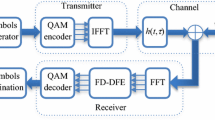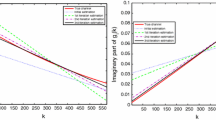Abstract
Inter-symbol interference (ISI) causes many errors in modulated symbols, when they are transmitted through band-limited channels. According to the multipath delay profile of the channel, the modulated symbol may disperse over more than one symbol period casing interferences among the received symbols. In this paper, the ISI signal is not considered as a problem, but it is exploited as a source of time diversity for the modulated symbols. The ISI signal is considered as if the modulated symbols are transmitted more than one time through different symbols periods. The number of periods over which the modulated symbol extends, represents the time diversity gain of the proposed system. In the proposed receiver, the interfering symbols are considered as symbols from different users. A multiuser detector is used to demodulate these interfering symbols. Moreover, a signal combiner is used to collect the detected symbol from the output of the multiuser detector through the dispersion period of the channel. The output of the combiner represents the decision variable to the baseband detector. The diversity gain in the decision variable in the proposed receiver is proportional to the dispersion period of the channel.













Similar content being viewed by others
References
Ankarali, Z., Pekoz, B., & Arslan, H. (2017). Flexible radio access beyond 5G: A future projection on waveform numerology & frame design principles. IEEE Access. https://doi.org/10.1109/access.2017.2684783.
Zhang, X., Chen, L., Qiu, J., & Abdoli, J. (2016). On the waveform for 5G. IEEE Communications Magazine, 54(11), 74–80. https://doi.org/10.1109/MCOM.2016.1600337CM.
Andrews, J. G., Buzzi, S., Choi, W., Hanly, S. V., Lozano, A., Soong, A. C., et al. (2014). What will 5G be? IEEE Journal on Selected Areas in Communications, 32(6), 1065–1082. https://doi.org/10.1109/JSAC.2014.2328098.
Basnayaka, D. A., & Haas, H. (2016). MIMO interference channel between spatial multiplexing and spatial modulation. IEEE Transactions on Communications, 64(8), 3369–3381. https://doi.org/10.1109/TCOMM.2016.2580146.
Xu, T., & Darwazeh, I. (2017). A joint waveform and precoding design for non-orthogonal multicarrier signals. In Wireless communications and networking conference (WCNC), 2017 IEEE. https://doi.org/10.1109/wcnc.2017.7925796.
Tuntoolavest, U., & Limchaikit, K. (2015). Scaling method to increase data rate with no degradation in vector symbol decoding performance. In Communications (APCC), 2014 Asia-Pacific conference on. https://doi.org/10.1109/apcc.2014.7091643.
Li, T., Wang, X., Fan, P., & Riihonen, T. (2017). Position-aided large-scale MIMO channel estimation for high-speed railway communication systems. IEEE Transactions on Vehicular Technology, 66(10), 8964–8978. https://doi.org/10.1109/TVT.2017.2703595.
Choi, J., Evans, B. L., & Gatherer, A. (2017). Resolution-adaptive hybrid MIMO architectures for millimeter wave communications. IEEE Transactions on Signal Processing, 65(23), 6201–6216. https://doi.org/10.1109/TSP.2017.2745440.
Chen, J., Hu, J., & Zhou, J. (2016). Hardware and energy-efficient stochastic LU decomposition scheme for MIMO receivers. IEEE Transactions on Very Large Scale Integration (VLSI) Systems, 24(4), 1391–1401. https://doi.org/10.1109/tvlsi.2015.2446481.
Minango, J., & de Almeida, C. (2017). Optimum and quasi-optimum relaxation parameters for low-complexity massive MIMO detector based on Richardson method. IEEE Electronics Letters, 53(16), 1114–1115. https://doi.org/10.1049/el.2017.1910.
Chen, X., Lu, J., Fan, P., & Letaief, K. B. (2017). Massive MIMO beamforming with transmit diversity for high mobility wireless communications. IEEE Access, 5, 23032–23045. https://doi.org/10.1109/ACCESS.2017.2766157.
Dinc, E., & Akan, O. B. (2015). Fading correlation analysis in MIMO–OFDM troposcatter communications: Space, frequency, angle and space-frequency diversity. IEEE Transactions on Communications, 63(2), 476–486. https://doi.org/10.1109/TCOMM.2014.2387159.
Liu, H., Zhou, S., Su, H., & Yu, Y. (2014). Detection performance of spatial-frequency diversity MIMO radar. IEEE Transactions on Aerospace and Electronic Systems, 50(4), 3137–3155. https://doi.org/10.1109/TAES.2013.120040.
Matolak, D. W., Remley, K. A., Holloway, C. L., Zhang, Q., & Wu, Q. (2014). Large-scale site and frequency diversity in urban peer-to-peer channels for six public-safety frequency bands. IEEE Transactions on Wireless Communications, 13(4), 2025–2033. https://doi.org/10.1109/TWC.2014.022614.130816.
Gozálvez, D., Gómez-Barquero, D., Vargas, D., & Cardona, N. (2013). Combined time, frequency and space diversity in DVB-NGH. IEEE Transactions on Broadcasting, 59(4), 674–684. https://doi.org/10.1109/TBC.2013.2281665.
Hassan, A. Y. (2015). Code-time diversity for direct sequence spread spectrum systems. Wireless Personal Communications, 84(1), 695–718. https://doi.org/10.1007/s11277-015-2656-z.
Phakphisut, W., & Supnithi, P. (2017). Design of LDPC codes for unequal ISI channels. IEEE Transactions on Magnetics. https://doi.org/10.1109/TMAG.2017.2700760.
Köken, E., & Tuncel, E. (2017). Joint source-channel coding for broadcasting correlated sources. IEEE Transactions on Communications, 65(7), 3012–3022. https://doi.org/10.1109/TCOMM.2017.2698031.
Hadi, S. Q., Ehkan, P., Anuar, M. S., & Dawood, S. A. (2016). Performance comparison of STBC-FT based OFDM wireless communication system using M-QAM and M-PSK modulation techniques. In 2016, 3rd international conference on electronic design (ICED). IEEE. https://doi.org/10.1109/iced.2016.7804631.
**ao, Z., Fu, S., Yao, S., Tang, M., Shum, P., & Liu, D. (2016). ICI mitigation for dual-carrier superchannel transmission based on m-PSK and m-QAM formats. Journal of Lightwave Technology, 34(23), 5526–5533. https://doi.org/10.1109/JLT.2016.2624758.
Aminjavaheri, A., Farhang, A., Rezazadehreyhani, A., Doyle, L. E., & Farhang-Boroujeny, B. (2017). OFDM without CP in massive MIMO. IEEE Transactions on Wireless Communications, 16(11), 7619–7633. https://doi.org/10.1109/TWC.2017.2752153.
Choi, J. (2017). Coded OFDM-IM with transmit diversity. IEEE Transactions on Communications, 65(7), 3164–3171. https://doi.org/10.1109/TCOMM.2017.2699182.
Berardinelli, G., Pedersen, K. I., Sorensen, T. B., & Mogensen, P. (2016). Generalized DFT-spread-OFDM as 5G waveform. IEEE Communications Magazine, 54(11), 99–105. https://doi.org/10.1109/MCOM.2016.1600313CM.
Proakis, J. (2007). Digital communications (5th ed.). McGraw-Hill Education. ISBN-13: 978-0072957167.
Hassan, A. Y. (2016). Double rate OFDM system in time varying channel. In IEEE symposium on computers and communication (ISCC) (pp. 1163–1170). https://doi.org/10.1109/iscc.2016.7543894.
Hassan, A. Y. (2017). A simple transmit diversity system for fading channels using shaped sinusoidal functions. AEU International Journal of Electronics and Communications, 76, 97–106. https://doi.org/10.1016/j.aeue.2017.03.024.
Hassan, A. Y. (2017). Increasing the symbol rate in QAM system using a new set of orthonormal basics functions. Journal of Electrical Systems and Information Technology. https://doi.org/10.1016/j.jesit.2017.05.007.
Hassan, A. Y. (2015). A wide band QAM receiver based on DFE to reject ISI in wireless time varying fading channel. AEU International Journal of Electronics and Communications, 69(1), 332–343. https://doi.org/10.1016/j.aeue.2014.10.005.
Hassan, A. Y. (2017). A novel structure of high speed OFDM receiver to overcome ISI and ICI in Rayleigh fading channel. Wireless Personal Communications, 97(3), 4305–4325. https://doi.org/10.1007/s11277-017-4726-x.
Rappaport, T. S. (2002). Wireless communications: Principles and practice (2nd ed.). Prentice Hall. ISBN-13: 978-0130422323.
Schonhoff, T. A., & Giordano, A. A. (2006). Detection and estimation theory and its applications. Pearson/Prentice Hall. ISBN-13: 9780130894991.
Hassan, A. Y., & Shaaban, S. M. (2014). Enhancement of noise performance in digital receivers by over sampling the received signal. International Journal of Industrial Mathematics, 6(4), 275–284.
Verdu, S. (1998). Multiuser detection (1st ed.). Cambridge: Cambridge University Press. ISBN-13: 978-0521593731.
Author information
Authors and Affiliations
Corresponding author
Additional information
Publisher's Note
Springer Nature remains neutral with regard to jurisdictional claims in published maps and institutional affiliations.
Rights and permissions
About this article
Cite this article
Hassan, A.Y. Enhancing Signal Detection in Frequency Selective Channels by Exploiting Time Diversity in Inter-symbol Interference Signal. Wireless Pers Commun 106, 1373–1395 (2019). https://doi.org/10.1007/s11277-019-06220-5
Published:
Issue Date:
DOI: https://doi.org/10.1007/s11277-019-06220-5




